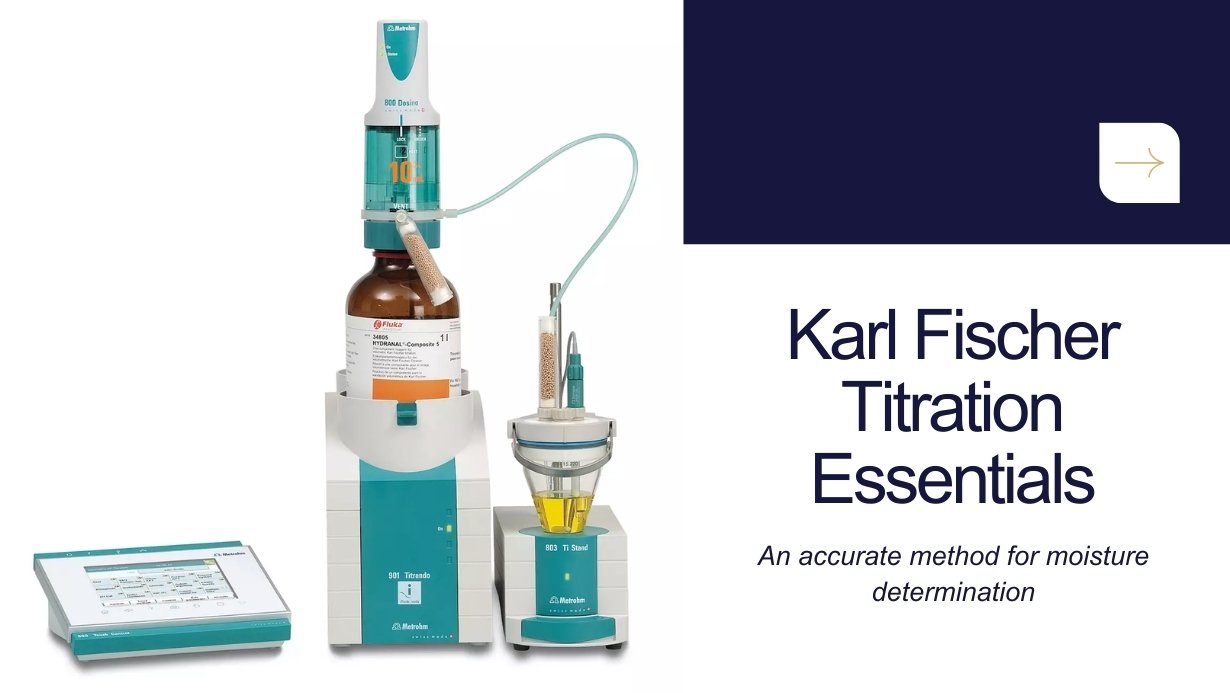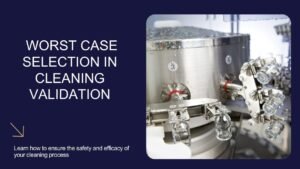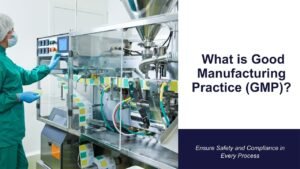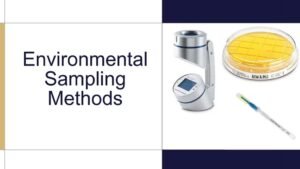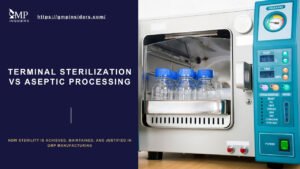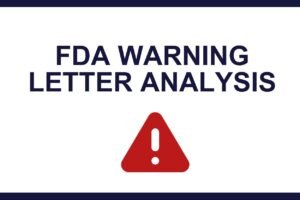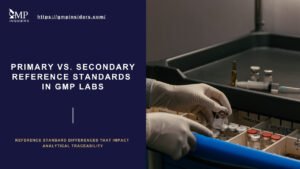Back in 1935, German chemist Karl Fischer introduced a method that changed the game for water content measurement. Known as Karl Fischer titration, this technique focuses specifically on water molecules, making it highly accurate and reliable. Unlike traditional methods that might measure other volatiles, KF titration ensures precision by targeting water alone.
What makes it so versatile is its two main approaches: volumetric titration for samples with moderate to high water content and coulometric titration for trace water levels. This adaptability, along with its exceptional sensitivity and broad measuring range, has earned it a spot in nearly every analytical laboratory.
Over the years, continuous improvements in instruments and reagents have made KF titration faster, more efficient, and easier to use. In this article, we’ll explore its history, how it works, and why it remains the go-to method for accurate water determination in quality control.
Key Principles of the Chemical Reactions in Karl Fischer Titration
To better understand how the Karl Fischer instrument works, it’s helpful to look at the key principles behind its operation and the chemical reactions that make the titration process possible.
Mechanism of Karl Fischer Reaction
The Karl Fischer titration relies on a two-step chemical reaction to precisely determine water content:
- Formation of Monosulfur Ester: Sulfur dioxide (SO₂) reacts with methanol (a common alcohol used in this process) to form a monosulfur ester. This reaction requires an amine base to stabilize the environment and promote reactivity.
- Reaction of Monosulfur Ester with Iodine and Water: Once formed, the monosulfur ester reacts with iodine (I₂) and water (H₂O). This step is tightly controlled by maintaining the pH within the range of 5-8, which ensures the reaction proceeds quickly and accurately.
While essential for buffering the reaction, the amine base does not directly participate in the Karl Fischer reaction. Instead, it serves to stabilize the pH within the optimal range (pH 5–7), ensuring the reaction proceeds rapidly and stoichiometrically.
The Karl Fischer reaction stops as soon as there is no more water in the titration cell. At this point, the addition of iodine leads to a slight excess, signaling the endpoint of the titration.
This well-controlled sequence of reactions allows Karl Fischer titration to accurately and selectively measure water content without interference from other components in the sample.
H₂O + SO₂ + I₂ + R-N → 2HI + R-N·SO₃
R-N·SO₃ + R-OH → R-NH⁺ + HSO₄-R
In this equation:
- I₂ (Iodine) is the primary reactant that reacts stoichiometrically with water. The amount of iodine consumed corresponds directly to the water present in the sample.
- SO₂ (Sulfur Dioxide) reacts to form sulfuric acid derivatives, facilitating water binding and driving the reaction forward.
- R-N (Base) acts as a buffering agent to neutralize the acidic by-products (HI and sulfuric acid derivatives) formed during the reaction. Historically, pyridine was the base of choice, but it has largely been replaced by imidazole due to its improved safety profile and performance.
- Methanol (R-OH) is the most common solvent in KF titration. It acts as both a medium for the reaction and a reactive alcohol, helping to solubilize sulfur dioxide and stabilize the intermediate products.
Types of Karl Fischer Titration: Volumetric vs. Coulometric
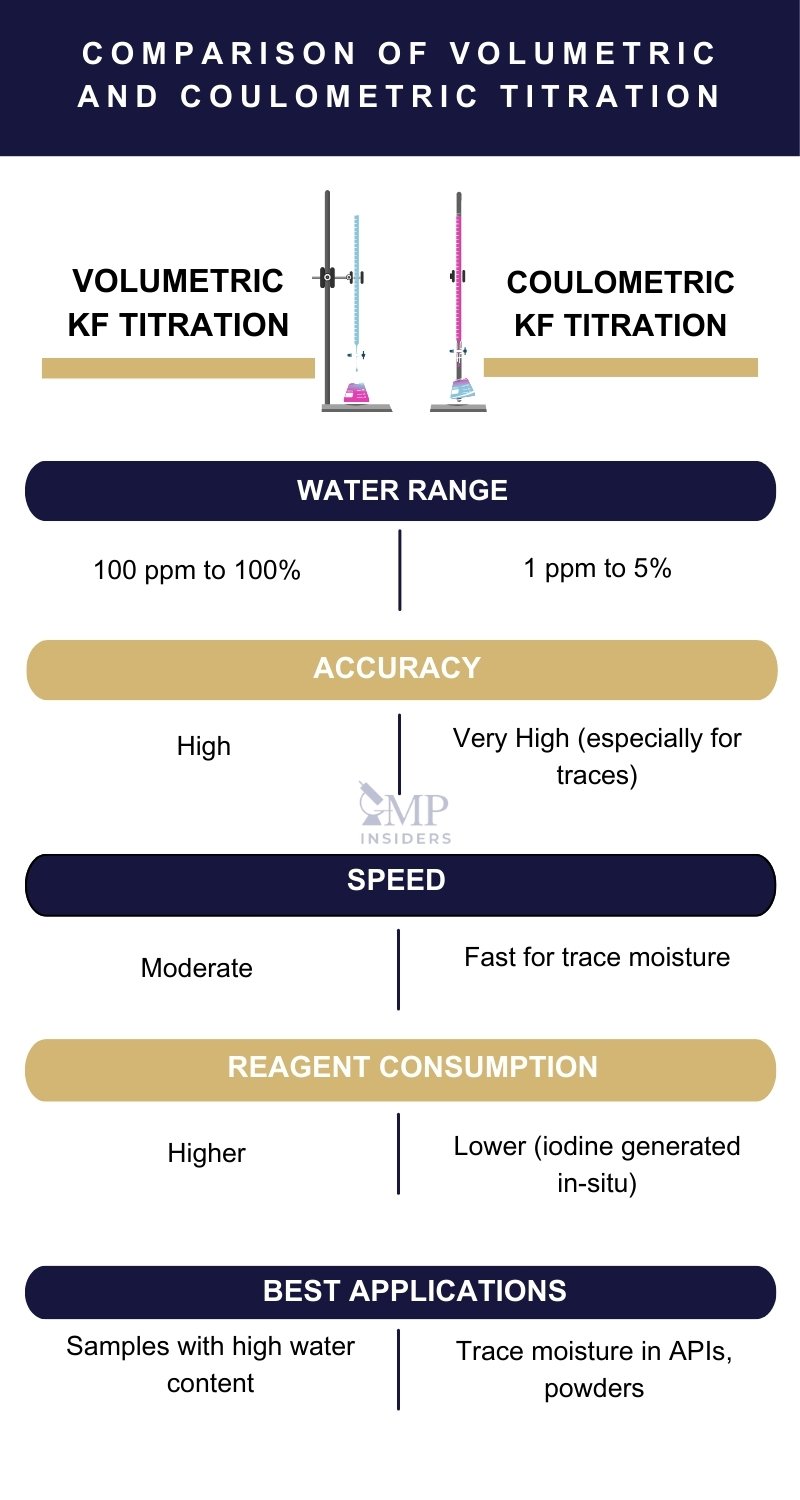
Water determination by Karl Fischer (KF) titration can be performed using Volumetric or Coulometric methods, depending on the sample’s water content. The choice between the two depends on the water levels present in the sample, the sample type, and the required sensitivity.
Volumetric Karl Fischer Titration
In volumetric KF titration, iodine is introduced into the reaction system through a pre-prepared titrant solution. The titrant contains iodine, sulfur dioxide (SO₂), a base (such as imidazole), and a solvent, typically methanol. The iodine reacts stoichiometrically with the water present in the sample, following the Karl Fischer reaction:
As the titrant is added, the water in the sample is consumed, and the reaction proceeds until all the water has reacted. The endpoint is determined using bipotentiometric sensors, which detect a voltage change when free iodine begins to accumulate, signaling that no water remains to react.
Volumetric KF titration is specifically designed for moderate to high water content analysis, typically measuring water levels from 0.01% to 100%. It is highly versatile and widely used for water determination in solids, liquids, and certain gases, particularly in pharmaceutical and industrial applications.
Advantages
- Suitable for a wide range of water content, from moderate to high levels.
- Applicable to various sample types, including solids, liquids, and certain gas samples.
- Fast and reliable for routine water content determination in bulk samples.
- Offers flexibility with one-component and two-component reagent systems to suit different analytical needs.
Typical Applications
- Raw Materials and Excipients: Determining water content in pharmaceutical raw materials and excipients ensures product quality and compliance with specifications.
- Liquid Formulations: Accurate water content analysis in solutions and suspensions prevents product instability.
- Tablets and Powders: Monitoring water content levels in finished products prevents caking, microbial growth, and chemical degradation.
- Oils and Lubricants: Ensures that moisture-sensitive industrial products meet strict quality standards.
Coulometric Karl Fischer Titration
Unlike volumetric titration, iodine is generated electrochemically in coulometric KF titration. When an electric current is applied to the anode in the titration cell, iodine is produced in situ.
The iodine immediately reacts with the water present in the sample. The amount of iodine generated is proportional to the charge passed through the solution, as described by Faraday’s Law. The endpoint is reached when all the water has reacted and excess iodine is detected.
Coulometric KF titration is specifically designed for trace water content analysis, measuring water levels as low as 0.0001% to 5%. It is particularly useful for analyzing very dry samples such as lyophilized drugs, specialized APIs, or gases where water content content must be tightly controlled.
Advantages
- Extremely sensitive, making it ideal for trace-level water content analysis.
- No need for pre-prepared titrants, as iodine is generated in situ.
- Accurate and reproducible results, even for samples with very low water content.
Typical Applications
- Lyophilized Formulations: Ensures stability of freeze-dried products like vaccines and biologics.
- Powders and APIs: Analyzing trace water levels prevents hydrolysis in sensitive pharmaceutical ingredients.
Specialty Gases: Detecting water content in gases critical for pharmaceutical manufacturing and storage.
KF Advantages Over Other Methods
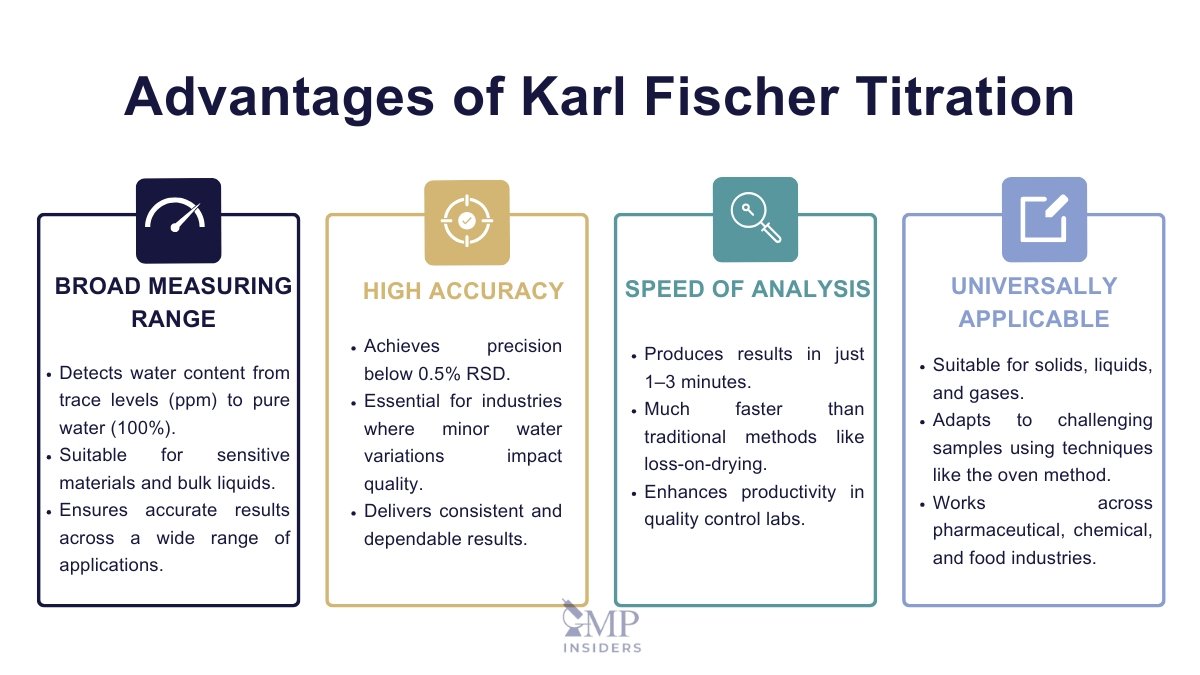
Unlike conventional techniques such as Loss on Drying (LOD), which measures the total loss of volatile components, including solvents and other volatiles, Karl Fischer titration specifically targets water and nothing else. This selectivity makes it the preferred choice for accurate water determination, especially in samples containing other volatile substances.
Broad Measuring Range
One of the most notable advantages of Karl Fischer titration is its broad measuring range, which extends from trace water levels in the parts-per-million (ppm) range to extremely high water concentrations, even up to pure water.
This exceptional range makes it suitable for diverse applications, from detecting minute amounts of water content in sensitive materials to quantifying water in bulk liquids. Whether the water content is minimal or significant, Karl Fischer titration provides reliable and reproducible results.
Accuracy and Precision
Very small standard deviations, typically below 0.5% relative standard deviation (RSD), can be achieved, ensuring consistent and dependable results. This level of precision is essential in industries such as pharmaceuticals, where even minor variations in water content can impact product quality, safety, and stability.
Speed of analysis
While other water content determination methods may take considerable time, Karl Fischer titration is highly efficient, with most results obtained within just one to three minutes. This rapid turnaround enhances productivity in laboratories, enabling faster decision-making in quality control and production processes.
Universally applicable
Karl Fischer titration method is suitable for a wide variety of sample types—solid, liquid, or gaseous. For solids that do not dissolve directly in the Karl Fischer reagent or for materials that release water only at elevated temperatures, techniques such as the oven method can be employed to extract water effectively without interfering with the titration cell.
Reagents Used in Karl Fischer Titration
Reagents are an essential part of Karl Fischer titration, as they enable the stoichiometric reaction necessary for accurate water content determination. Two primary types of reagents are used: one-component reagents and two-component reagents, each with distinct compositions and advantages.
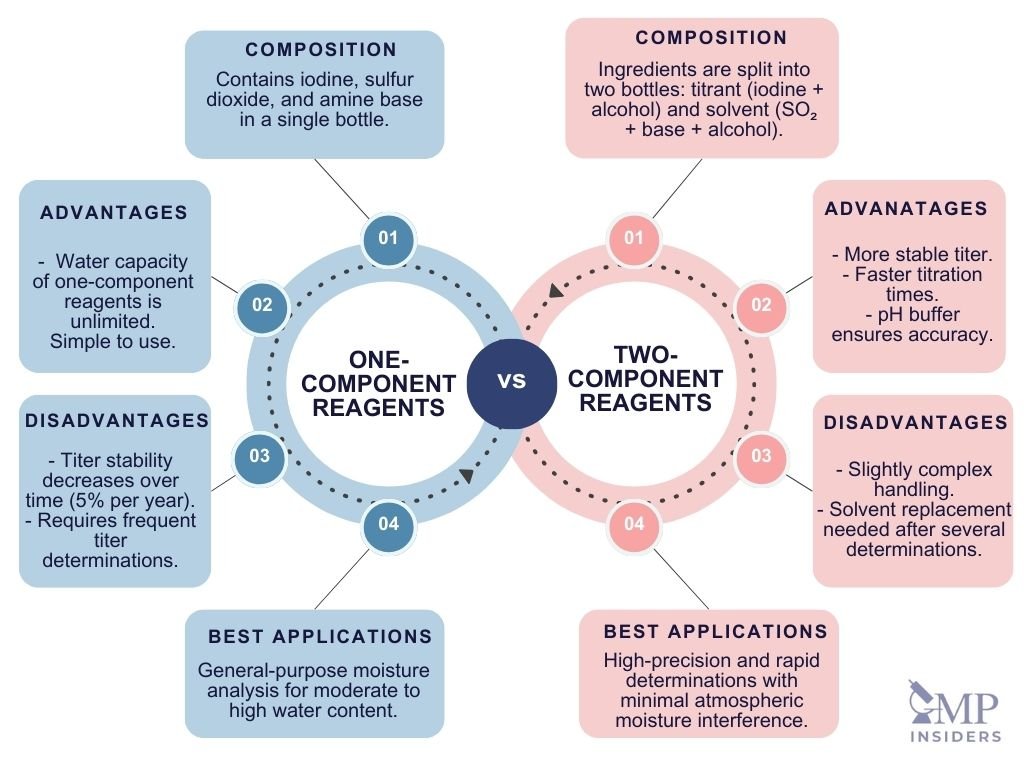
One-Component Reagents
In one-component systems, the titrant contains all the necessary ingredients for the Karl Fischer reaction—iodine, sulfur dioxide, and an amine base—dissolved in an alcohol, typically methanol. The solvent, in this case, consists solely of alcohol.
Advantages:
- Theoretically, the water capacity of one-component reagents is unlimited. Since sulfur dioxide and the base are added continuously with the titrant during the titration, the reaction can proceed without interruption.
- Simple to use, as only a single reagent is required.
Disadvantages:
- The titer is unstable because all components are stored in the same bottle. Even in a sealed container, the titer decreases by approximately 5% per year, necessitating frequent titer determinations to ensure accuracy.
- The alcohol content, such as methanol, must be closely monitored. To guarantee a stoichiometric reaction, at least 25% methanol must remain in the titration cell.
One-component reagents are well-suited for general-purpose water content analysis in moderate to high water content samples.
Two-Component Reagents
In two-component systems, the ingredients of the Karl Fischer reaction are split into two separate bottles:
- The titrant contains iodine and alcohol.
- The solvent contains sulfur dioxide, an amine base, and alcohol.
Advantages:
- The titer is more stable compared to one-component reagents because the ingredients are stored separately. This results in less degradation over time.
- The solvent in two-component systems contains a buffer, ensuring the pH remains optimal (5-8) even when slightly acidic or alkaline samples are analyzed. With one-component reagents, using pure methanol, the pH can shift more quickly.
- Faster titration times are achieved, which reduces the influence of atmospheric moisture, enhancing accuracy. This makes two-component reagents ideal for applications where high precision and rapid determinations are required.
Disadvantages:
- Sulfur dioxide is only present in the solvent and is not replenished during the titration. This makes sulfur dioxide the limiting factor, and the solvent must be replaced after several determinations to maintain the reaction’s stoichiometry.
- Slightly more complex handling, as two reagents must be managed.
Choosing Between One-Component and Two-Component Reagents
- One-Component Reagents are simpler to use but require frequent titer determinations due to their instability. They are best suited for situations where the titration speed is not critical, and sample acidity is controlled.
- Two-Component Reagents are preferred when accuracy, speed, and minimal atmospheric moisture interference are paramount. They are ideal for laboratories requiring rapid titrations and highly precise results.
Buffers in Karl Fischer Titration
Buffers ensure the pH remains within the optimal range of 5.5 to 8.0 during the titration. The reaction rate is at its peak within this range, as sulfur dioxide reacts more efficiently with water.
- Pyridine was traditionally used as a buffering agent but is now largely replaced due to its toxicity, strong odor, and slower reaction kinetics.
- Imidazole has replaced pyridine as the preferred base in modern Karl Fischer reagents. Imidazole offers several advantages, including:
- Faster reaction kinetics: It buffers the reaction medium more effectively, allowing the titration to proceed quickly.
- Improved safety and handling: Imidazole is less toxic and more environmentally friendly, addressing health and safety concerns.
Solvents in Karl Fischer Titration
The solvent in KF titration acts as both a reaction medium and an active participant in the reaction, particularly in alcoholic systems.
- Methanol is the most commonly used solvent due to its high reactivity and ability to stabilize intermediates formed during titration. In methanol-based solutions, the stoichiometry of the KF reaction is 1:1 (1 mole of water reacts with 1 mole of iodine).
- Alternative Solvents: Methanol may cause side reactions with certain sample types, such as aldehydes and ketones, resulting in false water content readings. For such cases, methanol-free reagents and alternative solvents are used, including:
- Ethanol: Less reactive with carbonyl compounds and suitable for sensitive samples.
- 2-Propanol and ethylene glycol monoethyl ether: Used when methanol causes interferences.
- Diethylene glycol monoethyl ether: Preferred for specific pharmaceutical applications requiring increased stability.
- Non-Alcoholic Solvents: When methanol is absent, the stoichiometry changes to 2:1 (2 moles of water react with 1 mole of iodine). These solvents, such as dimethylformamide (DMF), are used in specialized cases where methanol cannot be used.
Solvent Selection
Titer Determination in KF Volumetric Titration
The titer is a critical parameter in KF volumetric titration, as it defines the water equivalent of the titrant and directly impacts the accuracy of water content determination. Despite technological advancements in reagent production, Karl Fischer reagents still exhibit some degree of titer instability. As a result, regular titer determination is necessary to maintain precision and reliability in the analysis.
In KF volumetric titration, the titer is expressed in milligrams per milliliter (mg/mL), indicating the amount of water that reacts with one milliliter of titrant. For instance, a titer of 5 mg/mL means that 1 mL of the titrant reacts with exactly 5 mg of water.
Reagent manufacturers often design titrants with slightly higher titers (e.g., just above 5 mg/mL) to account for potential changes during storage or after the reagent bottle is opened. This approach ensures the titer remains consistent and above the intended value throughout its shelf life.
Equipment and Reagents used for Titrant Concentration Determination
To determine the titer accurately, the following equipment and reagents are required:
- Certified Water Standard with a known water content is essential for titer determination. The certified value ensures a reliable reference for the calibration of the titrant.
- Syringe and Needle are used to precisely transfer the water standard into the titration cell through the septum to avoid atmospheric moisture interference.
- Analytical Balance is used to determine the weight of the water standard. The syringe containing the standard is weighed before and after the addition, and the difference represents the exact amount of standard added.
Di-Sodium Tartrate Dihydrate (Primary Standard)
Di-sodium tartrate dihydrate (Na₂C₄H₄O₆•2H₂O) is ideal for titer determination due to its stability, non-hygroscopic nature, and exact water content of 15.66%.
Certified Water Standard
Certified water standards are liquid solutions with a standardized water content (e.g., 10 mg water per gram standard). Packaged in sealed ampoules, they provide consistent and reliable results by preventing moisture contamination or evaporation. With proper storage, these standards maintain their stability for up to 5 years, making them an ideal choice for laboratories requiring dependable references for water content analysis.
Pure Water
Pure water can also be used, but it requires exceptional precision due to the small sample size (10–20 µL). Handling errors or evaporation can lead to measurement inaccuracies. For this reason, di-sodium tartrate dihydrate or certified water standards are generally preferred for more reliable results.
Best Practices for Titer Determination in Karl Fischer Titration
To achieve accurate and reliable results during titer determination, attention to a few key details can make a significant difference:
- Rinsing the burette: Rinsing the burette with the Karl Fischer titrant before starting helps eliminate any residual moisture or contaminants that could affect accuracy.
- Maintaining consistent conditions: Conducting the titer determination under the same conditions as the sample analysis is key to achieving reliable results. This includes using the same titration stand, maintaining a consistent solvent volume, and ensuring the temperature and humidity remain stable to prevent solvent expansion.
- Ensuring complete dissolution: Ensuring that the standard dissolves fully is essential, as incomplete dissolution, often signaled by a cloudy solution, can lead to overestimated titer values. Taking the time to confirm full dissolution (prolonged pre-titration sample mixing) promotes precision.
Frequency of Titer Determination
The frequency for determining the titrant concentration depends on the type of titrant, environmental conditions, and desired accuracy:
- Weekly: Under stable laboratory conditions, weekly titer determination is generally sufficient.
- One-component titrants degrade faster, losing about 0.01 mg/mL per week.
- Two-component titrants are more chemically stable and require less frequent checks.
- Daily: For high-accuracy applications.
- Every 2-4 Hours: In laboratories with significant temperature fluctuations or where air conditioning is unavailable.
Factors Affecting Titrant Concentration
- Chemical Instability:
- One-component titrants degrade faster because all components-iodine, sulfur dioxide (SO₂), base, and solvent-are pre-mixed.
- Over time, chemical interactions between these components reduce the titrant’s concentration.
- Moisture Absorption:
- Anhydrous methanol or ethanol in the titrant is highly hygroscopic and absorbs moisture from the atmosphere. This can occur when:
- The desiccant in the titrant bottle is no longer effective.
- The titrant bottle is not tightly sealed after use.
- Anhydrous methanol or ethanol in the titrant is highly hygroscopic and absorbs moisture from the atmosphere. This can occur when:
- Temperature Changes:
- KF titrants contain up to 90% methanol or ethanol, which expands with rising temperatures. As volume increases, the concentration drops.
- Consistent temperature control is critical to prevent such variations.
- Standby Exposure:
- The plastic tubing in titration systems is not completely vapor-tight. When left idle, moisture from the atmosphere can slowly ingress, causing gradual titrant degradation. KF burette should be rinsed when the instrument has not been used for some time.
Sample Preparation Challenges in Karl Fischer Titration
Accurate sample preparation is the foundation of reliable water content analysis in KF titration. Improper handling can introduce significant errors, such as environmental moisture contamination, loss of volatile components, or incomplete reactions. Each sample type, whether solid, liquid, or gas, requires specific techniques to accurately capture its water content. By following best practices tailored to the sample’s characteristics, laboratories can achieve consistent and precise results, minimizing variability and avoiding common pitfalls.
Hygroscopic Solids
Hygroscopic solids like APIs and excipients quickly absorb atmospheric moisture, leading to inflated readings.
- Low-humidity environments, such as glove boxes or desiccators, can minimize moisture uptake during weighing and transfer.
- Quickly transferring samples to the titration vessel and sealing immediately helps reduce exposure.
Volatile Liquids
Volatile liquids, like acetone or ethanol, can evaporate during handling, causing moisture loss and inaccurate results.
- Using dry syringes and rinsing them with the sample before transfer ensures consistent handling.
- Injecting samples directly through septum stoppers helps maintain a sealed environment.
Gaseous Samples
Water content analysis in gases requires systems that prevent leaks and ensure accurate measurement.
- Using controlled flow rates allows all water content to be released and measured accurately.
- Preventing atmospheric contamination by employing sealed gas chambers or inlet systems ensures reliability.
Insoluble Samples – The Oven Technique
Insoluble samples or those causing side reactions with KF reagents are best analyzed using the oven technique.
- Heating the sample to extract water and transferring it to the titration cell ensures accurate analysis.
- This method is particularly effective for slow-releasing water samples or those incompatible with KF reagents.
Choosing the Right Sample Size
Proper sample sizing ensures accurate titration within the reagent’s detection range:
- High water content (>1%): Using small samples (50–200 mg) prevents reagent overload.
- Low water content (trace levels): Larger samples ensure sufficient water for accurate titration.
- Burette capacity: When determining sample size for Karl Fischer titration, it’s not just about water content; it’s also crucial to consider the burette capacity and the titrant potency. To achieve accurate and reproducible results, the volume of titrant used in each measurement should ideally fall between 50% and 100% of the burette capacity. This ensures that the system operates within its optimal range, avoiding errors caused by insufficient or excessive titrant use.
Example: For a 1% water content standard (10 mg/g), 5 mg/mL titrant potency, and a 5 mL burette, a sample size of 2 g is considered adequate.
Factors Influencing Accuracy in Karl Fischer Titration
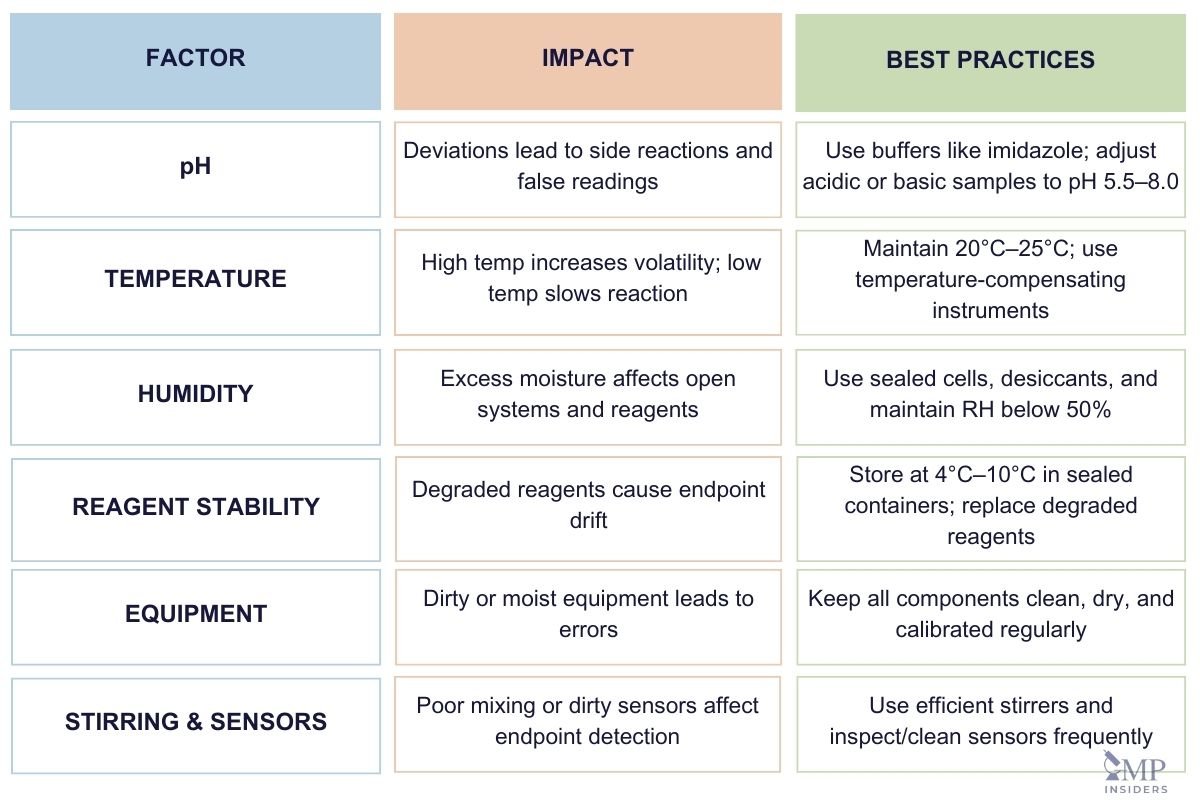
Achieving accurate and precise results in Karl Fischer (KF) titration requires careful control of various factors, including pH, temperature, reagent stability, environmental conditions, and equipment handling. Understanding and managing these variables is essential to ensure reproducible and reliable water content determination.
pH
The KF titration reaction is highly sensitive to pH. The optimal pH range is 5.5 to 8.0. Deviations from this range can lead to side reactions that compromise accuracy.
- Acidic Samples (pH < 5.5):
Excess acidity promotes the oxidation of sulfur dioxide (SO₂), which consumes iodine and leads to false endpoints.- Solution:
- Use buffering agents such as imidazole to neutralize acidity.
- Pre-titrate acidic samples with a weak base to adjust the pH before titration.
- Solution:
- Basic Samples (pH > 8.0):
Alkaline conditions can cause decomposition of sulfur dioxide, resulting in reagent instability and incorrect water content measurement.- Solution:
- Adjust the pH using an appropriate buffer solution.
- Use acidic solvents where compatible with the sample.
- Solution:
Temperature in Karl Fischer Titration
Temperature is critical in Karl Fischer titration, influencing reaction kinetics and reagent stability. Proper management ensures consistent and accurate results.
- Elevated Temperature:
- Increases solvent volatility (e.g., methanol), affecting reagent volume and concentration.
- Accelerates the chemical degradation of KF reagents.
- Low Temperature:
- Slows reaction kinetics, delaying endpoint detection and prolonging titration time.
Best Practices:
- Maintaining laboratory temperature between 20°C and 25°C ensures optimal stability and reaction rates.
- Using temperature-compensating KF instruments helps account for fluctuations in variable environments.
- Allowing reagents, solvents, and samples to equilibrate to room temperature before starting the titration promotes consistency.
Humidity in Karl Fischer Titration
Humidity can significantly affect the accuracy of Karl Fischer titration, particularly in open systems or laboratories with poor environmental control. Implementing proper measures can minimize its impact.
Best practices:
- Using sealed titration cells protects reagents and samples from moisture.
- Maintaining a controlled environment with relative humidity below 50% helps minimize interference.
- Placing desiccants like silica gel near the titration setup and during sample preparation absorbs excess moisture.
Stability and Storage of KF Reagents
Karl Fischer (KF) reagents are susceptible to degradation over time, primarily due to moisture absorption, evaporation, and chemical breakdown. These issues can lead to reduced titer values, endpoint drift, or incomplete titration, all of which compromise the accuracy of water content analysis. Proper storage and handling are essential to maintaining reagent stability and ensuring reliable results.
Best Practices:
- Storing reagents in tightly sealed containers helps prevent atmospheric moisture ingress.
- Maintaining storage temperatures between 4°C and 10°C improves reagent stability.
- Replacing reagents regularly, especially when signs of degradation such as endpoint drift or inconsistent results appear, ensures accurate results.
- Using desiccants in reagent bottles helps absorb excess moisture and protects reagents from environmental exposure.
Equipment and Calibration
Proper handling and maintenance of KF titration equipment are essential for accurate results.
- Glassware and Apparatus:
It is vital to ensure that all titration components, including burettes, titration cells, and syringes, are clean, dry, and airtight. Residual moisture in glassware can lead to false measurements. - Calibration:
Performing calibration frequently or before critical measurements ensures the system operates accurately and delivers reliable results.
Stirring and Endpoint Detection
Insufficient mixing and inaccurate endpoint detection can result in incomplete reactions and incorrect water content measurements.
Best practices:
- Using efficient magnetic stirrers promotes thorough sample dispersion in the KF reagent, ensuring a uniform reaction of all water with the titrant.
- Modern titration systems rely on bi-potentiometric sensors to accurately measure potential differences and identify the endpoint when all water has reacted. Regularly inspecting and cleaning these sensors is crucial to maintaining their sensitivity and ensuring consistent performance.
Modern Volumetric Karl Fischer Titrators
Modern volumetric Karl Fischer titrators are designed to simplify the titration process, enhance operational efficiency, and ensure accuracy in water content determination. These advancements address common challenges in reagent management and help maintain compliance with stringent quality standards.
Automatic Reminders for Titrant Usability
Modern titrators include built-in functionality to track the usable life of the titrant. These systems provide periodic reminders to check the reagent’s condition, ensuring operators are prompted to assess its stability before proceeding with critical analyses. This feature minimizes the risk of using reagents that may have partially degraded due to storage conditions or prolonged exposure.
Expiration Date Warnings
To further support reagent management, modern KF titrators monitor the shelf life of the titrant and issue alerts as the expiration date approaches. These warnings serve as early notice, allowing users to plan for titrant replacement before the quality of the reagent can impact results. This proactive approach reduces downtime and avoids the potential for costly rework due to failed analyses.
RELATED: Expiration Dates for Commercial and In-house reagents in QC Labs
Titration Blocking for Expired Reagents
One of the most significant advancements is preventing titrations with expired reagents. When the titrant exceeds its expiration date, the system automatically blocks titration operations to ensure only valid reagents are used. This safeguard protects the integrity of the analytical results and ensures compliance with good laboratory practices (GLP) and regulatory requirements, such as ISO standards or GMP guidelines.
RELATED: GMP vs GLP: Key Differences
Additional Features for Enhanced Accuracy
Modern titrators are often supported with data integrity, automatic calculations, and real-time monitoring of reagent quality. They may also feature temperature and humidity control measures to ensure consistency in challenging environmental conditions further.
These advancements in Karl Fischer titrators streamline routine operations and contribute to the reliability and accuracy of water content determination, reducing the likelihood of errors while maintaining strict adherence to quality and compliance protocols.
FAQ
How Do I Decide if My Sample Needs Volumetric or Coulometric Karl Fischer Titration?
The choice between volumetric and coulometric methods depends on the water content of your sample. If your sample has moderate to high water levels (100 ppm to 100%), volumetric KF titration is the best choice, as it can handle larger quantities efficiently. For trace water levels (1 ppm to 5%), such as in lyophilized drugs or specialty gases, coulometric KF titration is more suitable due to its higher sensitivity and lower reagent consumption.
What Are the Most Common Errors in Karl Fischer Titration, and How Can They Be Avoided?
The most common errors in KF include atmospheric moisture interference, improper sample handling, and degraded reagents. To avoid these issues:
- Ensure the titration cell is airtight to prevent moisture ingress.
- Work in a low-humidity environment and handle hygroscopic samples in a glove box or desiccator.
- Regularly check the reagent titer and replace reagents if signs of degradation appear. Properly storing reagents in sealed containers with desiccants can also extend their usability.
Can KF Titration Handle Samples That React With Methanol or Iodine?
Yes, Karl Fischer titration can handle reactive samples by using specialized methanol-free reagents or alternative solvents like ethanol or ethylene glycol monoethyl ether. These alternatives reduce unwanted side reactions, such as esterification in aldehydes and ketones, ensuring accurate water content measurement. Additionally, careful sample preparation and selection of appropriate buffers can further enhance the reliability of the titration for reactive substances.
Conclusion
Karl Fischer titration remains an indispensable tool for accurate and reliable water content determination across a wide range of industries. Its specificity, versatility, and precision make it the gold standard for water content analysis, whether working with trace water levels in lyophilized drugs or high water content in bulk materials. You can achieve consistent, reproducible results by understanding the key principles, optimizing your equipment and reagents, and following best practices for sample handling and endpoint detection.
With advancements in modern titration systems, such as automated reagent management and enhanced environmental controls, laboratories can streamline workflows and maintain compliance with stringent quality standards.

